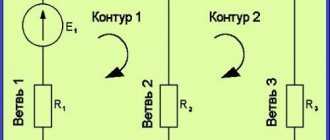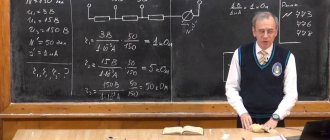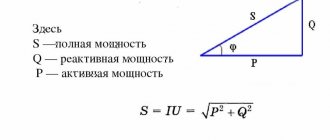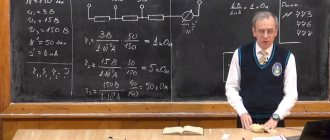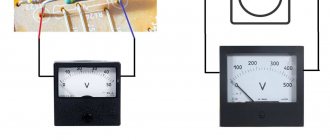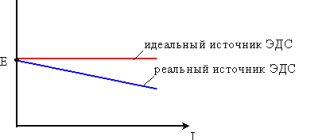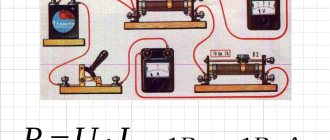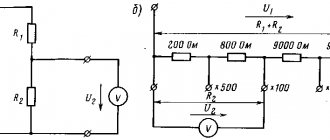Definition
The calculation of this parameter in an electrical circuit is based on the well-known law of conservation of energy. It follows from this that the instantaneous indicators transmitted from the source must be equal to the sum of the values received by consumers.
The balance for power is the well-known law of conservation of energy. The expression of this law in this case is the sum of all energy from the sources (generator or power supply) equals the amount received by the receivers.
An alternative option can be used. For it, the formula looks like the figure below:
It is worth taking into account that any electrical circuit has resistance. The described value with accompanying values is calculated taking into account the type of stress. Taking into account the law of conservation of energy, it is worth considering that energy is always transferred through an electrical circuit.
Drawing up a power balance
From the law of conservation of energy it follows that all the power supplied to the circuit from energy sources at any time is equal to all the power consumed by the receivers of the given circuit.
That is, IPconsumption = Psource.
The power of consumers, which are resistors in DC circuits, is determined by the formula
Pconsumption = I2R
Since the current is included in this expression squared, regardless of its direction, the power consumption is always positive.
The power of sources, which can be voltage sources and current sources, can be both positive and negative.
Source power emf. determined by the formula
A)
Pe.m.f.= EI
where I is the current in the branch with the emf source.
b)
If e.m.f. and the current of this branch coincide in direction (Fig. 19a), then the power P.m.f.
is included in the balance expression with the “+” sign,
if they do not coincide, then P.e.m.f. is the value
Fig. 19 negative.
The power of the current source is determined by the formula:
P.t.= IU
Where I is the value of the source current, U is the voltage at its terminals.
If the current I and voltage U act as shown in Fig. 19b, then the power is positive; otherwise it is negative. Consequently, when calculating the power of a current source, it is necessary to determine the magnitude and direction of the voltage at its terminals.
Task:
Control questions:
- What is an electrical diagram? What refers to the “electrical” and “geometric” elements of the circuit.
- Define serial and parallel connections of circuit elements.
- The concept of “circuit” in an electrical circuit.
- What is the difference between an active branch and a passive branch?
- Potential diagram, its purpose.
- State the rule for choosing signs when finding the potentials of points.
- Formulate a generalized Ohm's law. What is the scope of its application?
- Formulate Kirchhoff's first law. How to determine the number of nodal equations? Rule of signs when writing a nodal equation.
- Formulation of Kirchhoff's second law. How to determine the number of contour equations. Rule of signs when writing a contour equation.
- What is meant by power balance? How is the power of a voltage source, current source, or receiver determined?
- The power of which elements (active or passive) can be negative and what does this mean?
Alternating current
The power balance in a simple AC circuit is calculated using a more complex formula. Power balance in a simple sinusoidal current circuit takes into account complex, reactive and active parameters.
- Comprehensive. Consists of transmitted and received powers. It will be necessary to perform a calculation in which all terms on the left side of the formula are positive (come with + signs), provided that the direction of the charged particles “Ik” coincides with the “EMF”. The rule that “Jk” does not coincide with the direction of voltage “Uk” must be observed. If the conditions do not meet the specified requirements, all data on the left side of the formula becomes negative. The formula is given below.
- Active. The values given by the source are equal to those received by consumers. The calculation of active power is entirely dependent on the presented complex energy. The active value is consumable, non-renewable, as it is spent on the operation of devices. This calculation method and its formula are presented below.
- The reactive power of the source and the consumer are equal. The only difference is that this parameter is not wasted. This indicator simply circulates according to the scheme. The formula is presented below.
The main difference between the quantity under consideration is the presence of non-directional movement of alternating current through the conductors. The parameter of such a circuit can be increased or decreased (for example, by a generator), which can affect the final result.
Power and Energy Balance - Power System Wiki
Balance of power and energy
is calculated to determine the possibility of covering the load schedule and identifying the need to introduce new energy sources.
General provisions
The frequency of alternating current in the electrical network and the voltage at the nodes are the most important indicators of power quality. What these indicators have in common is that they are both related to power balances in the power system.
The frequency value at any time during normal operation is the same in all nodes of the electrical network. At the same time, voltage levels at different points of the network can vary greatly and at the same time in some nodes they comply, but in others they do not comply with the requirements of GOST and technological connection agreements. In this sense, voltage, as a power quality parameter, must be analyzed in each individual node of the power system.
Each moment of steady state in the electric power system corresponds to balances of active and reactive powers. The power balance equations can be written as:
; ,
where and are the total active and reactive powers of generating sources; and - total active and reactive powers of loads; and - total power losses in the elements of power supply systems and the electric power system; and — total power consumption for the power plants’ own needs; — total powers of compensating devices (the “+” sign corresponds to devices consuming reactive power, the “-” sign to generating ones); total reactive (charging) power generated by overhead power lines.
Sources of active and reactive power are generators of power plants: thermal, nuclear, hydraulic, combined cycle and gas turbine, in addition, sources of active power can be generating electrical installations of non-traditional energy sources (wind, tidal and geothermal stations, solar panels). Depending on the type and design, some non-traditional active energy sources consume reactive energy. While for synchronous generators of power plants, the reactive power consumption mode can only be short-term in emergency situations.
D.C
In a DC electrical circuit, voltage and power are always the same value. Therefore, the calculation is much simpler. You can make a calculation based on a fairly simple example.
- There is an emf “E” and a resistor “R” in the circuit. When calculating, the current strength must be found.
- I=E/R. We substitute the available values, we get I=10/10=1 ampere.
- This is how we found the current strength. Now we will need the power parameter of the receiver “R” and the source.
- Pist=I×E=1×10=10 Watt. This is the value for the source.
- Now, in order to find P for the receiver, we do the calculation as in the figure below.
- Now let's create a total balance - 10 watts = 10 watts. This calculation showed that equilibrium is maintained for the presented scheme.
When calculating the parameters of this circuit, it makes sense to take into account the receiver flow rate. When heated, the resistor releases heat, which means that electricity is converted into heat. Taking into account the physical law of conservation, the heat generated by the resistor will also be equal to 10 Watts.
General concept
Electric voltage is defined as the ratio of the work done by the field to transfer a test charge from one given point to another to the size of the potential. When a unit reserve is dislocated, work is performed that is equal to the voltage in the desired area. The total power is obtained by multiplying the work of the electric field for a unit charge by the number of potentials per specific unit of time.
In an alternating electrical circuit, 3 types of power are distinguished:
In an alternating electricity circuit, the formula for calculating direct current is used only to calculate instantaneous power. This indicator undergoes changes over time and has almost no practical meaning for all other calculations. The power average requires time integration. The instantaneous power is combined over a certain period to calculate the magnitude in the line with periodic changes in the alternating flux strength and sinusoidal voltage.
The concept of complex numbers is used to relate all three types of power. This concept means that in an alternating circuit the load is expressed by a similar number so that the active variety appears to be a real component. The reactive indicator is an imaginary indicator, and the total power is shown in modulus form. These calculations take into account the phase angle φ, which is an argument for the power balance in the AC circuit.
Active power
The active conversion rate is also expressed through the mutual ratio of the flow force, voltage to the value of the active component of the resistance. In the line of sinusoidal and non-sinusoidal movement of electrons, the active load is equal to the sum of similar values in individual sections.
The average instantaneous conversion rate in a single-phase circuit is taken as the rms value of current and voltage with a certain shift angle. In non-sinusoidal electricity circuits, power is equal to the sum of the corresponding indicators of individual movements. With the help of active power, the intensity of the irreversible modification of electricity into other types, for example, electromagnetic or thermal, is characterized.
Electrical circuit conversion method
How to determine the current strength in individual circuits of complex circuits? To solve practical problems, it is not always necessary to clarify the electrical parameters of each element. To simplify calculations, special conversion techniques are used.
Calculation of a circuit with one power source
For a series connection, use the summation of electrical resistances discussed in the example:
Req = R1 + R2 + … + Rn.
The loop current is the same at any point in the circuit. You can check it at the break in the control section with a multimeter. However, on each individual element (with different ratings) the device will show a different voltage. According to Kirchhoff's second law, the result of the calculations can be clarified:
Source
